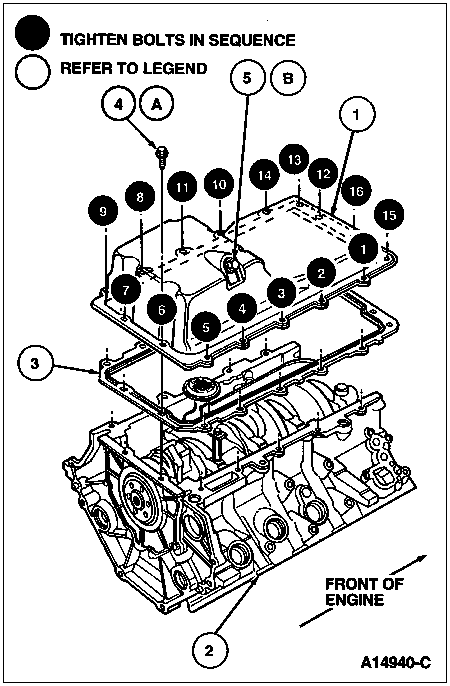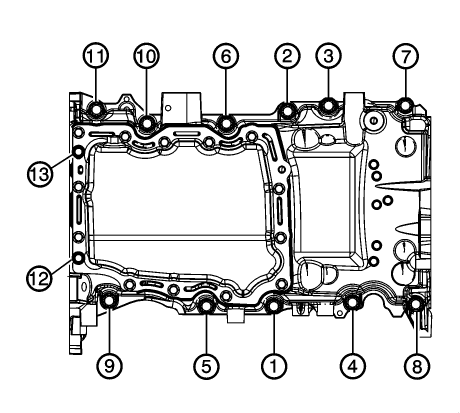


The LS engine family, produced by General Motors, has been widely used in various vehicles since the late 1990s. Proper installation and torque specifications are crucial for ensuring the longevity and optimal performance of these engines. One critical component that requires careful attention during installation is the oil pan. Adhering to the correct torque sequence and specifications for the oil pan bolts is essential to prevent oil leaks, maintain structural integrity, and ensure proper alignment with other engine components.

One of the most common issues I've encountered is oil leaks caused by an improperly torqued oil pan gasket. When the oil pan isn't secured correctly, the gasket can't seal properly, leading to leaks at the front and rear main seals. These leaks not only create a mess but can also result in low oil levels, which can cause severe engine damage if left unchecked.
Another problem that can arise is misalignment between the oil pan and the engine block. This misalignment can occur when the bolts aren't tightened in the correct sequence or to the proper torque specifications. A misaligned oil pan can cause excessive wear on the gasket, leading to premature failure and, you guessed it, more oil leaks.
Here's a table summarizing the common issues and consequences:
| Issue | Consequence |
|---|---|
| Improperly torqued oil pan gasket | Oil leaks at front and rear main seals |
| Misalignment between oil pan and engine block | Excessive gasket wear, premature failure, oil leaks |
When a customer brings in their vehicle with suspected oil pan issues, the first step is a thorough inspection. I always start by examining the mating surfaces of the oil pan, engine block, and covers for any damage or debris that could prevent a proper seal. Even a small scratch or a speck of dirt can compromise the gasket's ability to seal correctly.
Next, I'll check for any visible oil leaks around the oil pan gasket area. If there are leaks, I'll trace them back to their source to determine if the issue is indeed related to the oil pan installation or if there's another underlying problem.
In some cases, misalignment between the oil pan and the engine block can be visually apparent, especially in the rear transmission bell housing area. If I suspect misalignment, I'll take a closer look and check for any signs of uneven gasket compression or distortion.
The inspection and diagnosis process can be summarized as follows:
Inspect mating surfaces for damage or debris
Check for visible oil leaks around the gasket area
Look for signs of misalignment, especially in the rear bell housing area

Once the issue has been diagnosed, it's time to get to work on the repair. The first step is to thoroughly clean all mating surfaces to ensure a proper seal. Even the smallest debris can cause problems down the line.
For plastic oil pans, I'll carefully inspect the isolator seal and ensure it's properly installed in the groove. This seal helps dampen vibrations and prevent premature gasket failure.
Next, I'll apply a thin bead of sealant, such as Permatex, at the four corners of the oil pan gasket. This extra layer of protection helps prevent leaks and ensures a proper seal.
Before installing the oil pan, I'll loosely insert all the bolts to ensure proper alignment. Then, I'll follow the specified torque sequence and values for the specific LS engine I'm working on.
Typical torque values for LS engines:
| Bolt Location | Torque Specification |
|---|---|
| Outer oil pan bolts to engine block | 18 ft-lbs |
| Oil pan bolts to rear cover (bell housing area) | 106 in-lbs |
Some sources recommend a two-step torquing process, where the bolts are initially torqued to a lower value and then brought up to the final specification in a specific sequence. This method helps ensure even gasket compression and proper sealing.
For proper alignment, especially in the rear bell housing area, I'll sometimes install the transmission bell housing first, tighten the oil pan bolts that go into the bell housing, and then remove the bell housing. This extra step helps ensure the oil pan is perfectly aligned with the engine block before final torquing.
The repair procedure can be summarized as follows:
Clean all mating surfaces
Inspect and install isolator seal (for plastic oil pans)
Apply sealant at the four corners of the gasket
Loosely insert all bolts for proper alignment
Follow the specified torque sequence and values
Consider a two-step torquing process
Install bell housing first for proper alignment (if necessary)
As with most automotive repairs, prevention is key. To avoid issues with the oil pan installation, I always stress the importance of following the torque specifications and sequence precisely as outlined in the service manual for the specific engine.
Inspecting and replacing any worn or damaged gaskets and seals is also crucial. Even a small tear or crack in the gasket can lead to a leak down the line.
Keeping all mating surfaces clean and free of debris is another essential step. I've seen too many cases where a tiny speck of dirt or a stray thread has caused a leak that could have been easily prevented.
Finally, I recommend re-torquing the oil pan bolts after the initial installation, especially if the vehicle will be driven under heavy loads or in extreme conditions. This extra step ensures that the gasket has properly compressed and sealed over time.
Here are the key prevention and maintenance steps:
Follow torque specifications and sequence precisely
Inspect and replace worn gaskets and seals
Keep mating surfaces clean and debris-free
Re-torque oil pan bolts after initial installation
The cost of repairing an oil pan leak or addressing issues with the installation can vary depending on the specific problem and the labor involved. Typically, you can expect to pay for replacement gaskets or seals, which can range from $10 to $50, and a small amount for sealant, usually around $5 to $10.
If you're taking your vehicle to a mechanic, the labor costs can range from $100 to $300 or more, depending on the shop's hourly rate and the complexity of the job. However, if you're comfortable working on your vehicle and have the necessary tools, you can save a significant amount by performing the repair yourself, with the costs limited to the required parts and materials.
Here's a table summarizing the potential costs:
| Cost Item | Typical Range |
|---|---|
| Replacement gaskets/seals | $10 - $50 |
| Sealant | $5 - $10 |
| Labor costs (at a mechanic shop) | $100 - $300+ |
| DIY repair (parts and materials only) | Cost of parts and materials |
Proper oil pan installation and torque sequence might seem like a minor detail, but it's crucial for the longevity and performance of your LS engine. By following the correct procedures, using the right tools, and paying attention to the little details, you can avoid costly repairs and ensure your engine runs smoothly for years to come.
As an automotive mechanic, I've seen firsthand the consequences of improper oil pan installation, and I can't stress enough the importance of doing it right the first time. Whether you're a DIY enthusiast or taking your vehicle to a professional, understanding the significance of the oil pan torque sequence can save you time, money, and a whole lot of headaches down the road.
An improperly torqued oil pan gasket can lead to oil leaks at the front and rear main seals. These leaks can cause low oil levels, which can result in severe engine damage if left unchecked.
Inspect the mating surfaces for damage or debris, check for visible oil leaks around the gasket area, and look for signs of misalignment, especially in the rear bell housing area.
Applying a thin bead of sealant at the four corners of the oil pan gasket provides an extra layer of protection and helps prevent leaks, ensuring a proper seal.
Following the specified torque sequence and values is crucial to ensure even gasket compression and proper sealing, preventing misalignment and premature gasket failure.
The recommended torque value for outer oil pan bolts to the engine block on LS engines is typically 18 ft-lbs.
Installing the transmission bell housing first helps ensure proper alignment of the oil pan with the engine block before final torquing, especially in the rear bell housing area.
Keeping mating surfaces clean and free of debris is essential because even a tiny speck of dirt or a stray thread can compromise the gasket's ability to seal correctly, leading to leaks.
It is recommended to re-torque the oil pan bolts after the initial installation, especially if the vehicle will be driven under heavy loads or in extreme conditions, to ensure proper gasket compression and sealing over time.
The typical cost range for replacement gaskets or seals for an oil pan repair is between $10 and $50.
The potential labor cost range for an oil pan repair at a mechanic shop can vary from $100 to $300 or more, depending on the shop's hourly rate and the complexity of the job.

Sarah isn't your average gearhead. With a double major in Mechanical Engineering and Automotive Technology, she dived straight into the world of car repair. After 15 years of turning wrenches at dealerships and independent shops, Sarah joined MICDOT to share her expertise and passion for making cars run like new. Her in-depth knowledge and knack for explaining complex issues in simple terms make her a valuable asset to our team.












